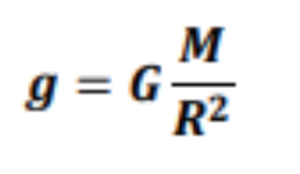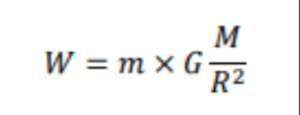Table of Contents
Introduction to Weight Formula
What is Weight?
The weight of an object is the measurement of the gravitational force acting on it. It is a measure of how strongly gravity pulls on the matter.
Formula of Weight
According to Newton’s second law of motion, force is equal to mass into acceleration,
F = m x a
When its acceleration due to gravity, a = g
F = m x g
This force due to gravity will be equal to the weight of the object, W. So,
W= m x g
This means the weight of an object is the product of its mass and acceleration due to gravity.
SI unit of Weight
The SI unit of weight is Newton (N) which is the same as Force. As the value of g at a particular place is constant, the weight of the object is directly proportional to its mass.
What is the difference between Mass and Weight?
The mass of an object remains constant everywhere whereas the weight on an object depends on the gravitational force at the location.
If an object of the same mass is placed at two different places and the gravitational force at one place is more than the other, then the mass of the object will be the same at both places. But, the weight of the object will be greater at the second place because the pull of gravity is stronger.
Why is the Weight of an Object on the Moon 1/6th the weight on Earth?
The mass of an object is the amount of matter present in it, and the weight of the object is the measure of gravitational force acting on it.
The weight ‘W’ of an object is equal to the product of its mass and acceleration due to gravity.

We also know the following formula of ‘g’ ,

Where, ‘G’ is the universal gravitational constant, M is the earth’s mass, and ‘R’ is the earth’s radius.
Substituting this in the first equation we get,

This is the object’s weight on planet earth. Let’s change it to W_{e} and slightly modify the right-hand side.

Similarly, the weight of the same object on moon can be represented as,

Where W_{m} is the weight of the object on the moon, M_{m} is the mass of the moon and R_{m} is the radius of the moon.
The universal gravitational constant is the same everywhere and also the mass of an object remains the same.
On dividing the third equation by the second one, we get,
Cancelling out ‘G’ and ‘m’, we get,
These four values are constant. After substituting them, we get the ratio as 1:6. Thus, the weight of an object on the moon is of its weight on the earth.
Solved Examples on Weight Formula
Example 1: A person with a mass of 70 kilograms is standing on the Moon’s surface, where the acceleration due to gravity is approximately 1.6 m/s2. Determine the person’s weight on the Moon.
Solution:
Given:
Mass (m) = 70 kilograms
Acceleration due to gravity (g) on the Moon = 1.6 m/s2
Weight (W) = 70 kg × 1.6 m/s2
Weight (W) = 112 Newton (N)
Therefore, the person’s weight on the Moon is 112 N.
Example 2: A box weighs 200 Newton on the surface of the Earth. What is the mass of the box?
Solution:
Given:
Weight (W) = 200 Newton
Acceleration due to gravity (g) on Earth = 9.8 m/s2
We can rearrange the formula to solve for mass: Mass (m) = Weight (W) / Acceleration due to gravity (g).
Mass (m) = 200 N / 9.8 m/s2
Mass (m) = 20.41 kilograms
Therefore, the mass of the box is approximately 20.41 kg.
Related Physics Formulas
Frequently Asked Questions on Weight Formula
What is weight?
Weight is the force exerted on an object due to the gravitational pull of a celestial body, such as Earth. It is the measure of the heaviness of an object and is dependent on its mass and the acceleration due to gravity.
How is weight different from mass?
Mass is a measure of the amount of matter in an object and is a scalar quantity. It remains constant regardless of the location of the object. On the other hand, weight is a measure of the force acting on an object due to gravity and is a vector quantity. It varies depending on the acceleration due to gravity at a particular location.
What is the difference between weight and mass on Earth?
Mass is a fundamental property of an object and remains constant regardless of its location. Weight, however, is dependent on the gravitational pull of Earth. On Earth, weight and mass are directly proportional, with the formula: Weight = Mass × Acceleration due to gravity.
How is weight measured?
Weight is typically measured using a scale or balance. A scale measures the force exerted by an object due to gravity, which corresponds to its weight. Common units of weight include Newton (N) in the International System of Units (SI) system.
How does weight change on different celestial bodies?
Weight varies depending on the gravitational pull of the celestial body. For example, an object will weigh less on the Moon compared to Earth because the Moon has less gravitational force. Similarly, an object will weigh more on a planet with a stronger gravitational field, such as Jupiter.
Can weight and mass be the same?
Weight and mass are not the same. Mass is a measure of the amount of matter in an object, while weight is the force exerted on an object due to gravity. However, on Earth's surface, the weight of an object is often used as a measure of its mass since the acceleration due to gravity is relatively constant.
Can weight be negative?
Weight is a vector quantity, so it can have both positive and negative values. The sign of weight depends on the direction of the gravitational force relative to a reference point. In most cases, weight is considered positive when the force is directed downward, as is the case on Earth









